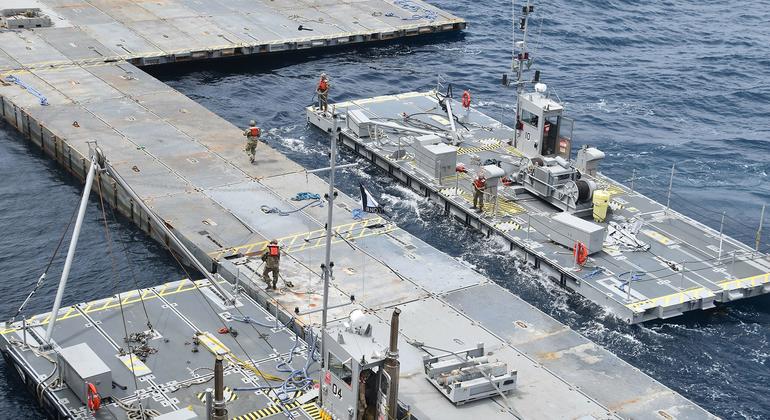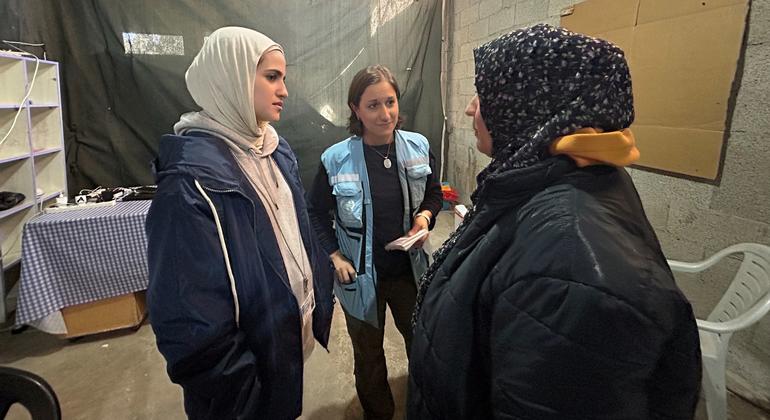“No matter where you look, no matter where you go, there’s destruction, there’s devastation, there’s loss,” said Yasmina Guerda, who recently returned to Gaza for a second deployment with the UN humanitarian affairs office, OCHA.
She spoke to UN News from Rafah, previously a refuge for more than a million Palestinians fleeing hostilities in other parts of Gaza. The start of Israeli military operations there has uprooted more than 600,000 people in just over a week.
Ms. Guerda frankly discussed the immense suffering and insecurity in Gaza, the critical lack of aid and basic services, and the difficulties facing humanitarians working amidst “the constant soundtrack of war”.
The mother of two young boys also urged people worldwide, who are upset over the conflict, to ask themselves “What can I do today at my level to help end this nightmare?”
This interview has been edited for clarity and length.
Yasmina Guerda: We would need to invent brand new words to adequately describe the situation that Palestinians in Gaza find themselves in today. No matter where you look, no matter where you go, there’s destruction, there’s devastation, there’s loss. There’s a lack of everything. There’s pain. There’s just incredible suffering. People are living on top of the rubble and the waste that used to be their lives. They’re hungry. Everything has become absolutely unaffordable. I heard the other day that some eggs were being sold for $3 each, which is unthinkable for someone who has no salary and has lost all access to their bank accounts.
Access to clean water is a daily battle. Many people haven’t been able to change clothes in seven months because they just had to flee with whatever they were wearing. They were given 10 minutes notice and they had to run away. Many have been displaced six, seven, eight times, or more.
One of the things that I find absolutely striking is the people’s determination to keep moving forward, to keep looking up no matter what.
I was walking through a camp recently and there were several families who had dug their own makeshift septic tank with spoons in the sand, grabbing pipes and toilet tanks from destroyed buildings so that they can have something that resembles a restroom, because the situation here for water and sanitation is extremely dire. Humanitarians are not allowed to import the supplies to build latrines in displacement sites, so every family has to find their own creative way to solve that. I have been around several humanitarian crises, and you don’t encounter this kind of grit everywhere.
Forced displacement and military operations in Rafah are worsening an already catastrophic situation.
UN News: You’re in Rafah. What is the level of destruction there and how close is the fighting?
Yasmina Guerda: We are currently based in the western side of Rafah and the fighting is mostly in the east, and we hear the destruction that is happening. We go for reconnaissance missions which is, of course, extremely dangerous. Two of our colleagues went on a “recce” mission earlier this week and, unfortunately, one of them didn’t come out of it alive and the other had to be medically evacuated. So, the destruction in Rafah is happening. I haven’t personally seen it with my own eyes yet.
We have been able to see what has happened in the other areas that the Israelis have been attacking, so Khan Younis, Deir al Balah, and the northern parts of Gaza. What I can tell you is that there is rubble everywhere. The level of destruction is unimaginable, and the exception is to find buildings that are still standing. You’ll see a sea of rubble, and then every so often you’ll find a building that is still standing.
UN News: What are the challenges faced by humanitarian agencies in getting aid to civilians in need, particularly while civilians are on the move?
Yasmina Guerda: This is my second deployment to Gaza. I was here four weeks ago, and in four weeks everything has changed, including how you get in and out of Gaza and how you bring in supplies. Most of the population used to be in Rafah because that was the safer area back then. But now, of course, 630,000 people in 10 days have packed up whatever they had and gone north or towards the coastal areas.
The situation is constantly shifting because of the fighting that is so intense. One of the challenges for the response is that the minute you put something in place, the minute you think you know something, you have to change everything and start from zero. So that is extremely challenging, and it is slowing down the response a lot.
The second issue is that honestly, it’s extremely dangerous to be here and that is really putting the response on its knees. There are no safe places left in Gaza.
On the last week of my deployment, seven humanitarian colleagues, who also happened to be friends, were killed by Israeli airstrikes. And the day that I arrived for my second deployment, two humanitarians were again struck. We constantly have to be careful with every move. We have to notify the warring parties of every movement. We spend hours submitting paperwork, we spend hours waiting at checkpoints, and so often it is for nothing because many of the missions that we planned are not facilitated, so we can’t carry them out.
Then there’s all the other stuff that you can imagine. The very poor phone and Internet connectivity is making it very, very hard to coordinate amongst humanitarian actors. Living conditions are stressful due to the constant soundtrack of war – the drones, the airstrikes – and in some areas there are bodies in the streets that we have to remove to ensure that they get a dignified burial.
We see a lot of very difficult things. It’s very challenging mentally and emotionally, and I would say a lot of aid workers are tired, and it’s also, I think, hurting the response because this is a very challenging response. But the worst of all are the issues and hurdles that we face.
It’s really unprecedented how utterly difficult it is to bring staff and supplies into Gaza. This was always the case since 7 October, but since 7 May, when the main border crossing for aid closed – the Rafah crossing – our storage facilities have been destroyed and looted. There’s almost nothing left to distribute in Gaza. And so as soon as something comes into the Strip – and it’s a trickle – it has to go out for distribution, and of course, it’s nowhere near enough. We have to make very difficult choices every day, and we have to prioritize the most vulnerable. We have to deliver partial rations. And that’s honestly quite heartbreaking on a daily basis.
Two boys gaze out at the ocean at a beach, in Rafah, Gaza, April 2024.
UN News: Many people around the world are upset by the conflict and the destruction. What is your message to them?
Yasmina Guerda: People here don’t understand how the world is allowing this to happen. When I entered Gaza the first time, the Ministry of Health had reported that about 29,000 people had been killed. By the time I left five weeks later, the number had risen to 34,000 reported killed. I calculated that this is about six people killed per hour on average, mostly women and children. We know that. We’re starting to identify bodies, and we’re letting it happen.
I’m lucky. I’m the mother of two little boys, they are two and four, and I’m terrified that one day they’re going to ask me how we couldn’t stop this; how the world didn’t stand in solidarity and voice their outrage loudly, and loudly enough to make it stop?
I don’t have an answer, and I think my message would be that people need to reach out to their decision-makers and demand that international law be respected, that the most basic human rights and the most basic human dignity be respected.
We’re not asking for much, just for the law that already exists to be respected because this war is a stain on us all, and it is everyone’s responsibility to work at all levels to make it stop now. That’s my message: that everyone asks themselves every day, “What can I do today at my level to help end this nightmare?”














